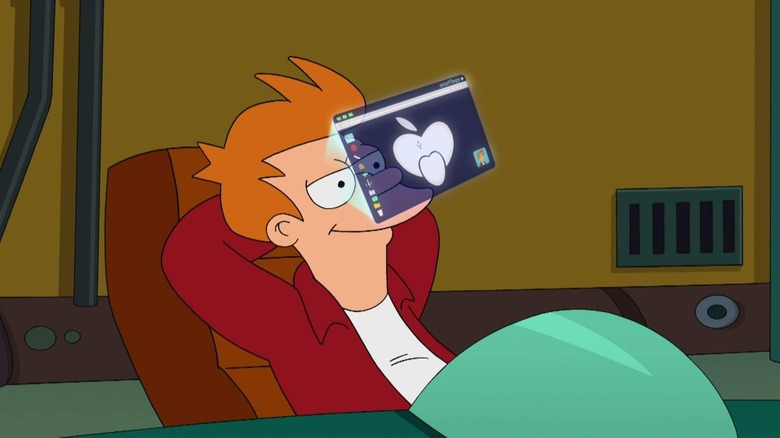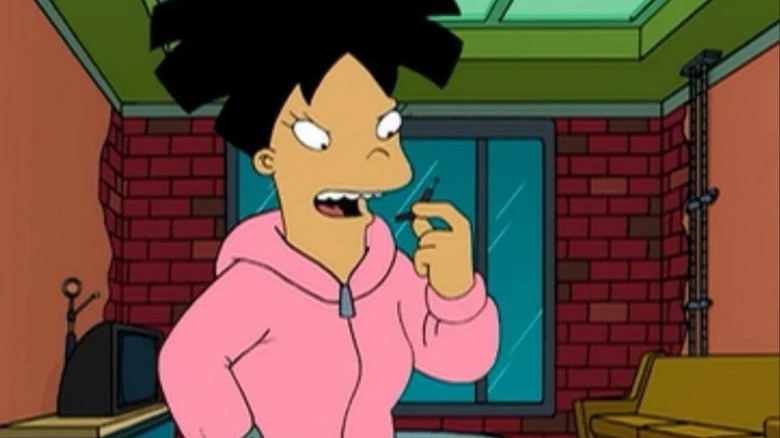One Of Futurama's Predictions For Our World Ended Up Being Completely Wrong
When "Futurama" debuted in 1999, smartphones weren't yet ubiquitous. There were some computer-like phones on the market, of course — tech-savvy nerds might recall IBM's Simon from 1994 — but the first wireless internet-ready phones weren't put on the mass market until 2001. The first iPhone wasn't introduced until 2007, and by then, "Futurama" had already been canceled for the first time. As such, when one sees the 31st-century characters on "Futurama" using cell phones, they are extrapolated from the cellular technologies of the present. It wouldn't be until the 2011 "Attack of the Killer App" that modern iPhone technology would be addressed on "Futurama," and the showrunners depicted a world where eyePhones were implanted directly into the users' eyeballs.
During the writing of the episode "Amazon Women in the Mood" (February 4, 2001), the most popular cell phone on the market was the Nokia 3310. Some people may have also still had their old Motorola StarTACs, released in 1996. Cell phone trends in 2001 were pushing the technology toward smaller and smaller flip-phones, some of which were about the size of a Reese's peanut butter cup when folded. "Compact" and "sleek" were the design mandates of the day. As such, when Amy Wong (Lauren Tom) uses a cellphone in the episode, it's a flip phone about the size of a Tic-Tac. It's a parody that no longer plays.
"Futurama" co-creator David X. Cohen and "Amazon" writer Lewis Morton couldn't have predicted the widespread use of touchscreen smartphones in 2001, of course, so they kinda got this one wrong. Cohen prides himself in trying to accurately predict the real-life future of technology for his animated sci-fi sitcom, and he admitted — in a 2023 interview with Insider — that he blew his prediction with Amy's mini mobile.
The CellMate
"Amazon Women in the Mood" was also written at a time when many mobile phones had to be stored on specialized cradles that were left plugged into the wall; this was long before people switched to mere charging cords. As such, Amy's teeny-tiny phone — amusingly called the CellMate — was stored on an outsize cradle about the size of a particularly fancy espresso machine. The phone is small and the charging station is enormous. It wasn't exactly hard-hitting satire, but it would play to an audience in 2001.
In 2023, however, Cohen was embarrassed. "They were getting smaller and smaller," he said, "It was like a cigarette lighter. You just ... you hold it by your ear and they could hear you. That was way off the mark." Luckily, the "Futurama" team made good with "Attack of the Killer App," and they wisely invented a holographic, implanted cell phone technology that still only exists in the realm of sci-fi. Well, kind of. Samsung is currently developing a contact lens that can fill the wearer's field of vision with information, as well as take pictures. It's not a "Futurama" eyePhone, but we're getting close.
"Futurama" did, however, accurately predict the future a few times. "Futurama" predicted the coming of wrist-mounted smart devices, Smell-o-scopes, suicide booths, and even customizable robot clones.
And, heck, maybe cell phone trends will change by the year 3001. Perhaps tiny flip phones will come back into vogue. We'll only have to wait another 977 years to see.

